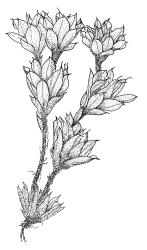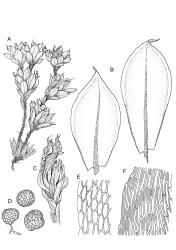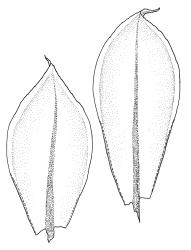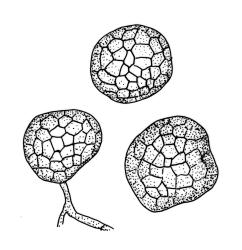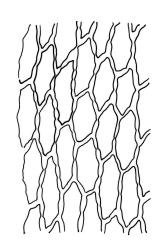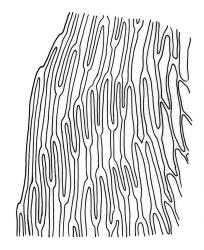- ≡ Bryum perlimbatum Cardot, Bull. Herb. Boissier sér. 2, 5: 1007 (1905)
- = Rosulabryum perlimbatum J.R.Spence & H.P.Ramsay, Telopea 8: 333 (1999) nom. inval.
Plants medium-sized to large, yellow-green, comose (sometimes serially), forming compact turves. Stems red-brown, mostly c. 15–20 mm, not or moderately branched by innovations arising within the perichaetia, beset below with red-brown, densely papillose rhizoids, in cross-section as per genus. Leaves enlarged and comose at stem apices, wide-spreading when moist, more erect and ± spiralled around the stem when dry, widest above mid leaf, obovate to spathulate, and ± narrowed to base, abruptly tapered to an acute, narrowly triangular-cuspidate and reflexed apex, (2.5–)3–4.5 × 1–1.3 mm (in comae, those on lower stem smaller) and with lamina ≥0.9 the total leaf length, concave, not pigmented at base, denticulate (occasionally nearly entire) in upper third, with a very strong, pale, and conspicuous border, recurved below, not decurrent; upper laminal cells hexagonal-rhombic, firm-walled and porose, mostly 40–63 × 12–16 µm and c. 3:1, becoming longer and more oblong below; marginal cells forming a very wide (commonly of 10–12 cells at widest part of leaf) but poorly defined border that extends to apex and fuses with cells of the costa. Costa excurrent or merging with the elongate cells of the triangular and sharply pointed cusp. Brood bodies (tubers) usually present on rhizoids, dark red-brown, oval or round, with cell walls not protruding, 150–300 µm diam.
Dioicous. Perichaetia terminal or overtopped by innovations, the inner leaves much smaller than those of the comae, lanceolate. Perigonia not seen. Setae single, short, 7–14 mm; capsules pendent, clavate-cylindric, c. 3 mm, details not seen in N.Z. material. Spores not seen.
Ochi 1970, fig. 33 (as Bryum perlimbatum); Mohamed 1979, figs. 25–26 (as B. perlimbatum).
NI: S Auckland (Tauranga); SI: Nelson (Mt Euclid), Canterbury (Porters Pass, Port Hills, Mt Berard), Westland (Mt Priestly), Otago (Signal Hill, Taieri Gorge, Lee Stream, Paradise). According to Spence & Ramsay (2006, p. 331), this species also occurs on "subantarctic islands", but they do not specify particular islands.
Austral. Reported from southern Chile, Argentina, and the Falkland Is., and tentatively from South Africa by Mohamed (1979); Magill (1987, p. 384) also recorded it from South Africa. The single NI collection cited consists of one sterile stem and lacks the characteristic tubers of the species; confirmation of additional NI collections is needed. The Nelson and Westland L.D. localities are both in the Paparoa Range. Reported from Marlborough L.D. (Kaikōura) by Mohamed (1979).
On soil, usually in proximity to streams or seepages; three collections from the Paparoa Range were from granite-derived soils. Ranging from c. 300–1020 m on SI.
Rosulabryum perlimbatum is easily confused with both R. capillare and R. subtomentosum. From R. capillare it is best distinguished by its wider leaf border, reflexed leaf apex, and its strongly and often serially comose habit. From R. subtomentosum it is distinguished by having smaller and more abundant tubers, wider leaf borders, less distinctly toothed leaf margins, and shorter setae.



